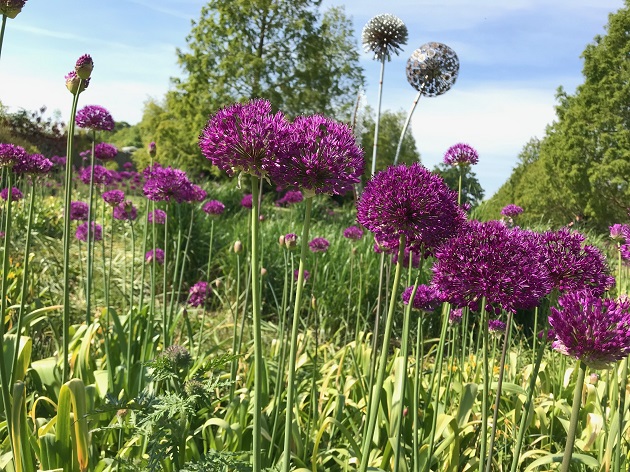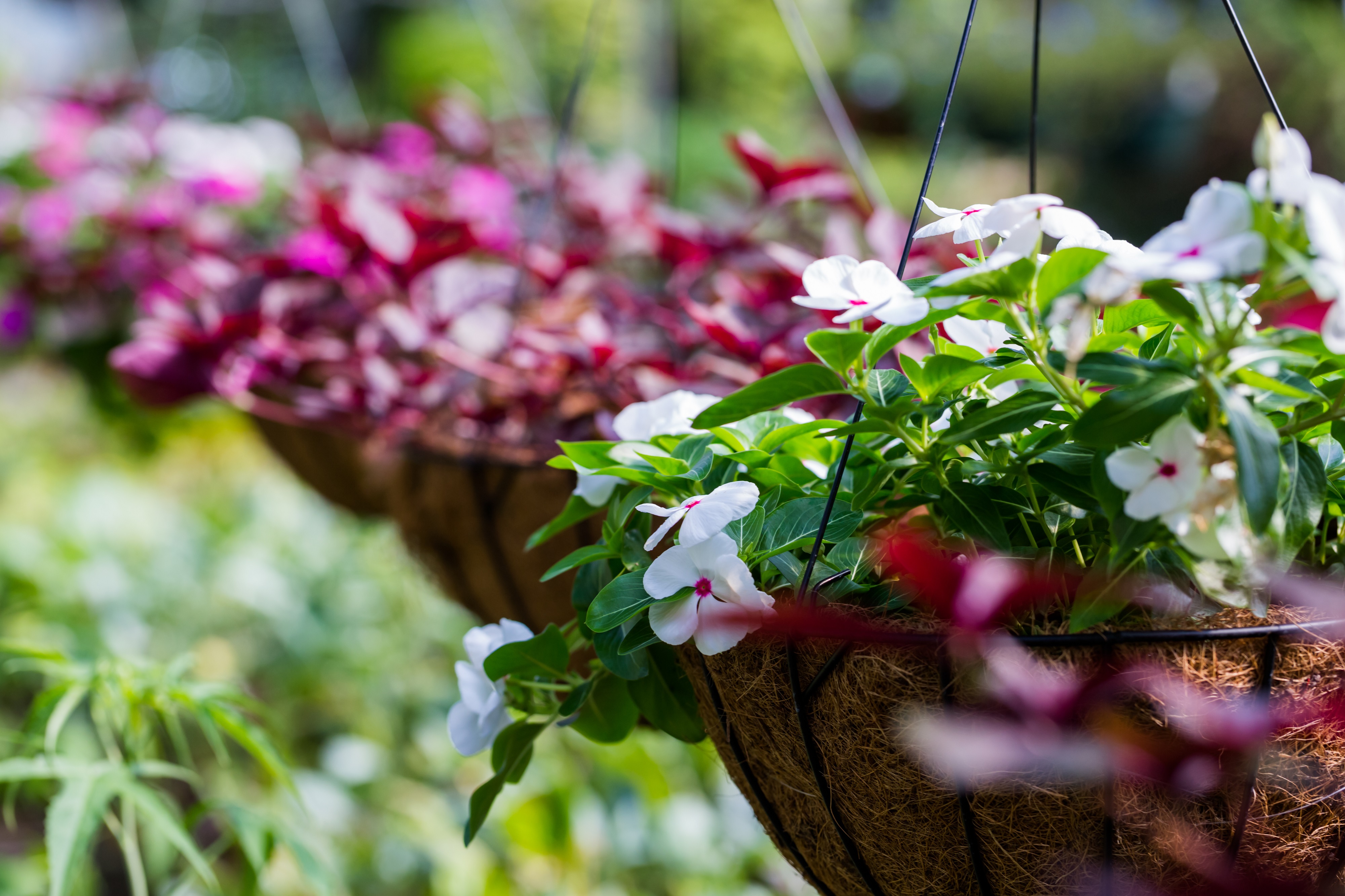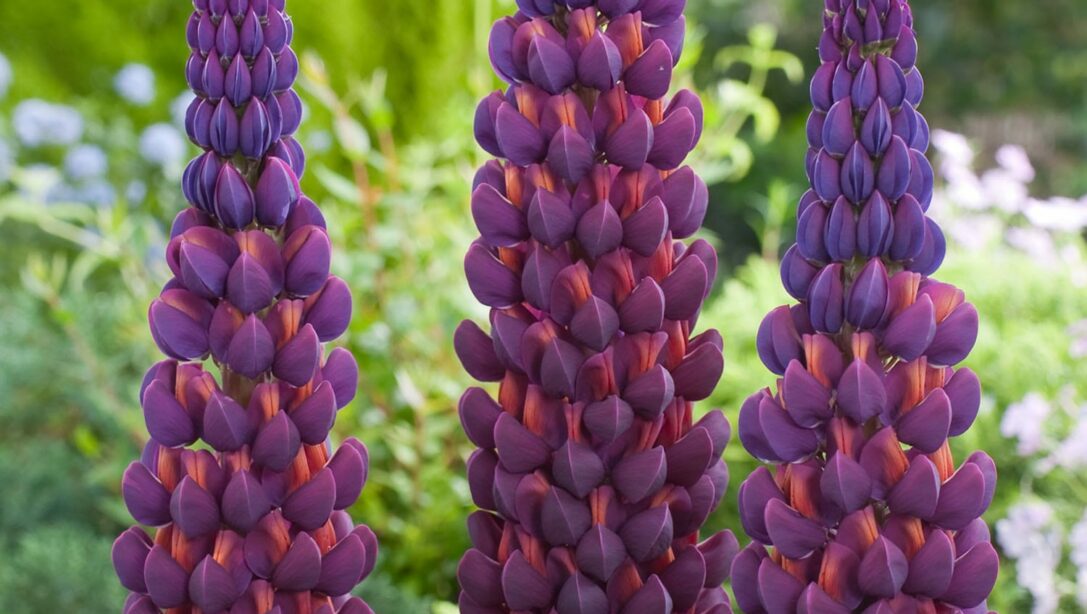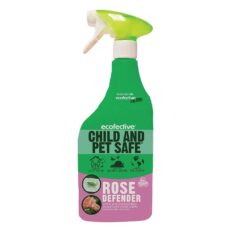The first of the summer months is here, including the longest day of the year. While we all hope for summer sunshine and opportunities to stop and enjoy in our June garden, there are plenty of enjoyable activities to be getting on with — particularly the care and maintenance of your plants.
Read our guide to June gardening jobs to find out what to do now, what to plant this month and helpful gardening tips from our Hillier experts to keep your garden at its best.
What to Enjoy in your Garden in June
 Alliums photographed at Sir Harold Hillier Gardens
Alliums photographed at Sir Harold Hillier Gardens
Gardening is as much about appreciating the beautiful now as planning and planting for the future. Enjoy these plants in your garden and home this month:
Flowering in June
- Climbers: summer-flowering clematis varieties, Hydrangea petiolaris, passiflora
- Summer-flowering shrubs: abutilon, calycanthus, Convolvulus cneorum, cytisus, deutzia, genista, Hydrangea macrophylla, photinia, syringa (lilac)
- Lavender varieties: Lavandula stoechas (French lavender) and Lavandula angustifolia (English lavender)
- Roses
- Perennials: alliums, acanthus, aquilegia, astrantia, campanula, delphinium, dahlias, dianthus, echinacea , gaura, gazania, geranium, helenium, leucanthemum, lily varieties, marguerite, Papaver orientalis, tiarella, lupins, peonies, primula (e.g. P.beesiana, P. bulleyana ), ranunculus, salvia, scabiosa, verbascum
- Summer bedding plants
- Alpines: Lithodora ‘Heavenly Blue’, saxifrage, phlox
- Trees: cornus, crataegus (hawthorn), malus
Great for Foliage and Structure
- Hostas, heucheras and tiarellas
- Ornamental grasses
- Ferns, aucuba, cotinus, fatsia, physocarpus, sambucus
Houseplants
- Flowering now: Begonias, kalanchoe, orchids, roses
- Great for foliage: Adiantum (and other ferns), alocasia, chlorophytum, cordyline, schefflera, cacti and succulents
What to Plant in June
 Hanging baskets bursting with colour
Hanging baskets bursting with colour
By June, the risk of frost in your garden should be gone. While there should already be plenty to enjoy, there are also a number of plants that can be added now for instant and future impact.
What to Plant for Instant Impact
Gardening is often about the patient process of growing from seed, bulb or small plant and nurturing it over time. If you want to balance this out with immediate colour, foliage and scale in your garden, you can always find larger plants and those in bloom right now for instant impact.
Simply browse the ‘flowering now’ list above. Many of these plants will be available from the Garden Centre for immediate enjoyment and, once planted, should continue to develop year after year.
Planting Outdoors
- You can now plant outdoors those plant varieties that have been brought on in the greenhouse.
What to Plant for Future Interest
- Late summer-flowering perennials: agapanthus, crocosmia, osteospermum, rudbeckia
- Alpines – 9cm or 1-litre plants allow for a cost-effective garden update
- Later-flowering shrubs, such as hardy fuchsia and Hydrangea paniculata varieties
- Plant up hanging baskets for summer-long colour
- Sow sunflowers, either into a pot or directly into flower borders
- Sow poppies outdoors
What to Grow in June
 Lettuce – can be grown together with perennials in the herbaceous border
Lettuce – can be grown together with perennials in the herbaceous border
In June in the vegetable garden, the harvest of delicious salad crops and the first of the potatoes begins. This is the month to stay on top of your weeding, watering and feeding routine.
Sow Indoors
- Sow courgette, marrows, squash and pumpkin seeds into seed cells or individual pots, placed on a light windowsill or in a warm greenhouse
Sow Outdoors
- Sow brassicas and leeks
- If you didn’t sow them in May, runner beans can now be planted directly
Hillier tip: These climbers will need a support to grow up and a wigwam is a simple and attractive solution. Simply place three to four bamboo canes into the ground and tie together at the top. Sow the seeds around each cane at the base – you will only need a single seed at the base of each cane for climbing runner and French beans.
- Continue to sow beetroot, carrots, French beans, mangetout, peas and radishes
- Sow radishes, lettuce and salad
Hillier tip: If your garden lacks space for a separate vegetable patch, plant lettuces in your borders along with your herbaceous plants, which has the added benefit of continuity of interest
- Potatoes planted earlier in the year will need ‘earthing up’ to increase the number of potatoes produced. Mound soil around the shoots and cover most of the stems, using the soil that is already there. This process should be repeated every two to three weeks throughout May and June
Harvest Now
- Kale, lettuce, peas, radishes, rocket, spinach, carrots, first early potatoes, broad beans, early courgettes, herbs, rhubarb, strawberries
Hillier tip: See the planting and harvesting times for many of our most loved vegetable and salad plants in our Seed Sowing Calendar.
Other Grow Your Own Activities
- Be vigilant with weeding! Little and often is the key
- Pests such as slugs and vine weevils may be problematic at this time of year. Make sure you have your desired pest control method in place
- Water – lower frequency and higher volume is best
- Help deter pests in your vegetable plot by ‘companion planting’
Hillier tip: Planting marigolds in your vegetable patch can deter whitefly and also attract ladybirds, which will help to control aphids. They also emit a substance from the roots that deters nematode worms in the soil. Plant nasturtiums alongside your brassicas to attract cabbage white butterflies away from your precious greens. Plant pungent vegetables, such as onions, garlic or chives next to your carrots to deter carrot fly. Read our guide to companion planting for more advice.
- Look at your plant supports – if your tomatoes are leaning, for example, it’s not too late to add a little more support
Gardening Jobs for June

As the daylight hours reach their peak, there are enjoyable maintenance activities to do in the garden in June along with rest and appreciation.
Plants to Prune
- Deadhead bedding plants to encourage prolonged flowering
- Deadhead finished spring bulbs
Hillier tip: When deadheading spring bulbs, like tulips, leave the foliage in place as this will feed the bulbs for the next year
- Deadhead tired looking perennials, like geraniums and delphiniums, to encourage a second flush of flowers
Hillier tip: As the first flush of flowers fade on herbaceous plants, cut the flower stems back hard and feed. This will encourage new flower growth to develop.
- Deadhead roses frequently as the first flush fades to encourage repeat flowering
Hillier tip: When deadheading roses, cut down to the next outward facing bud and always cut shoots at a side angle. That ensures that water runs over the cut and down the stem
- This is the month to prune many spring-flowering shrubs that have finished flowering
- Reshape topiary, including bay trees
- Prune evergreen hedging, like yews
Plants to Feed
- Feed roses with special rose feed with high potash as they grow. This will encourage a stronger, healthier flower
Hillier tip: High potash feeds are also ideal for tomatoes and fruit trees as they promote strong fruit production and increased sugar levels, meaning higher yields and sweeter fruit.
- Applying a good feed regularly, particularly to containers and baskets, will help keep your garden in full bloom
Plants to Protect
- Limit pest attacks on roses by spraying with a product like Rose Clear 2-in-1 in late May. Pick off any diseased leaves and destroy.
- When planting any herbaceous plants that have a tendency to grow floppy, add support as early as possible so they will grow up around it
- Gently tie in climbing roses as the new bud growth develops. Tie growth horizontally to encourage flower growth.
Lawncare & Gardencare
- Think about your watering routine. Containers, in particular, may want regular watering as warm weather and wind can quickly dry soil
Hillier tip: Always make sure you water at the base of the plant so it reaches the roots. When watering, let the water sink down into the soil then repeat two or three times until the water no longer goes down quickly. If you hoe around plants, water will penetrate where it’s needed instead of running off
- Install a water butt if space allows to collect and recycle rainwater over the coming year
- On warmer days, open greenhouse vents and doors to keep it cool and ventilated and to prevent disease and fungus problems
Looking After Birds and Wildlife in June

As the temperature rises the ground becomes harder, making it more difficult for birds to source worms. On hot days, birds need extra water to stay hydrated and maintain a cool body temperature.
- Continue to feed regularly with a high protein food, like sunflower seeds
- Ensure clean water is available. Top up frequently in warm weather
Hillier tip: Read more about looking after our winged friends in our guide to year-round bird care
In summer, butterflies and bees require a continued food source for survival and you will be rewarded with the sight of them flitting happily around your garden in the warm sunshine. Recommended plants at this time of year include allium, aquilegia, buddleja (‘The Butterfly Bush’), ceanothus, dahlia, lavender and roses.
Monthly Gardening Tool Checklist

Some of the essential garden tools and products we recommend to have ready in your shed.
Planting:
- Digging fork and spade, multi-purpose compost
Earthing up potatoes:
- Trowel or draw hoe
Sowing outdoors:
- Plant labels, trowel, watering can (or hose plus suitable attachment)
Pruning and deadheading:
- Pruning shears / secateurs
Ready for July? Discover your July garden.
Was This Article Helpful?
Join the Hillier Gardening Club to get the latest gardening news and advice
Find Out More





